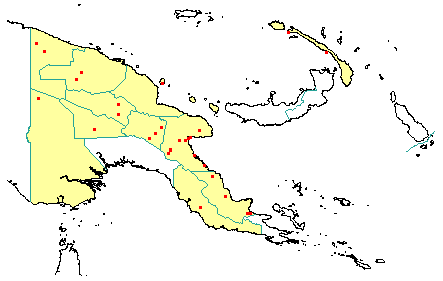
in PNGplants database
PNGTreesKey – Elaeocarpus dolichostylus Schltr. |
Barry Conn (NSW) & Kipiro Damas (LAE).
Guide to trees of Papua New Guinea
Copyright held by the authors, National Herbarium of New South Wales, and Papua New Guinea National Herbarium
Botanische Jahrbucher für Systematik, Pflanzengeschichte und Pflanzengeographie Vol. 54: 112 (1916) Fig. 4.
Other Literature: M.J.E. Coode, Handbooks of the Flora of Papua New Guinea 68-70 (1981) Fig. 16.
Family: Elaeocarpaceae
Dicotyledon
Timber Group: Commercial hardwood
Field Characters: Large canopy tree (up to 35 m high, less frequently to 40 m) or Small sub-canopy tree; Bole cylindrical (up to c. 60 cm diam.); straight (bole 10-16 m long); buttresses sometimes buttresses present or buttresses absent; spines spines absent; aerial roots aerial roots absent; stilt roots often stilt roots present or stilt roots absent; Bark slightly grey or dark brown, rough or smooth, slightly fissured; Subrhytidome (under-bark) green; less than 25 mm thick; bark blaze consisting of one layer; faintly to non-aromatic; outer blaze yellow (pale (straw-coloured), markings absent; inner blaze yellow (pale (straw-coloured), markings absent; bark exudate (sap) present, colourless, not readily flowing (spotty), not sticky; terminal buds not enclosed by leaves.
Indumentum: Complex hairs absent; stinging hairs absent; mature twig indumentum (hairs) present.
Leaves: Leaves spaced along branches, spiral (leaves occurring singly at a node and arranged spirally up the branchlet), simple (a leaf composed of a single blade); petiole present, not winged, attached to base of leaf blade, not swollen; leaves broadest above middle, (8.0-) 10.0-20.0 cm, 4.0-10.0 cm; symmetric, crenate, not dissected or lobed, obtuse or acute, venation pinnate, secondary veins open, prominent, intramarginal veins absent; leaves lower surface pale green, upper surface dark green (glossy (to mostly glossy) or green, indumentum (hairs) absent or present, indumentum (hairs) dense to sparse; absent; domatia absent; stipules absent.
Flowers: Inflorescence axillary, flowers on an unbranched axis, cones absent; flowers bisexual, stalked, flowers with many planes of symmetry, (7.0-) 8.0-12.0 mm long, diameter small (up to10 mm diam.) (8-10 mm diam.); perianth present, with distinct sepals and petals whorls, inner perianth white (cream-coloured); 4-5, free; stamens 10-15, present, free of each other, free of the perianth; ovary superior, carpels joined (when more than one), locules 3; styles solitary, 1.
Fruits: Infrutescence arranged on unbranched axis, fruit 35.0-50.0 mm long, blue, not spiny, fleshy, simple, indehiscent, drupe; seeds 1, to about 5 mm long, not winged, broad (as wide as long), seed 1-10 mm diam.
Distribution: West Sepik, East Sepik, Madang, Morobe, Western Highlands, Eastern Highlands, Southern Highlands, Western, Central, Northern, New Ireland.
 | Botanical records in PNGplants database |
Notes: Notes This species consists of two subspecies, namely, subsp. collinus has obviously hairy leaves and branchlets, whereas subsp. dolichostylus has less obviously hairy leaves and branchlets or hairs almost absent. The fruits of subsp. collinus are ellipsoid, pointed and 15-25 mm long, whereas subsp. dolichostylus has smaller globular fruits up to 10 mm long. The flowers of subsp. collinus are smaller (petals 7-8 mm long) than those of subsp. dolichostylus which have petals 11-12 mm long. The former subspecies occurs at higher elevations (1200-2050 m) whereas, subsp. dolichostylus occurs from sea level to less than 1000 m. There are some plants that appear to be intermediate between these two subspecies.